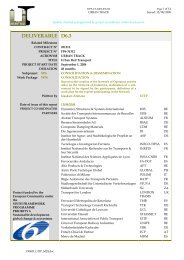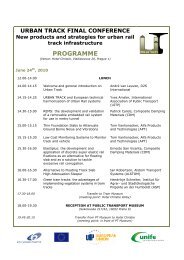DELIVERABLE 2.8 - urban track
DELIVERABLE 2.8 - urban track
DELIVERABLE 2.8 - urban track
You also want an ePaper? Increase the reach of your titles
YUMPU automatically turns print PDFs into web optimized ePapers that Google loves.
3. THE VIENNESE CURVE<br />
3.1. INTRODUCTION<br />
D0208_STIB_M24.doc<br />
TIP5-CT-2006-031312 Page 23 of 44<br />
URBAN TRACK Issued: August 13, 2008<br />
Quality checked and approved by project co-ordinator André Van Leuven<br />
From the very beginning of railway engineering the design of the ideal <strong>track</strong> geometry layout was a key<br />
problem. Two hundred years ago, with the debut of the steam engine simple geometric and kinematic<br />
basics were developed which are still valid today. From then to now engineers were busy to develop a<br />
<strong>track</strong> alignment that reduces forces in the wheel – rail contact point, minimizes wear of the <strong>track</strong>s and the<br />
wheels and that advances the safety of the passengers.<br />
A reduction of discontinuities (reduction in the mathematical order) was first proposed by F.R. Helmert<br />
in 1872 and G. Schramm in 1934, who replaced the straight course of the cant gradient and curvature by<br />
two curves, thus dividing the element into two. In 1936, A.E. Bloss proposed the simplest possible<br />
polynomial for a simple part element, which is now increasingly used. As early as 1907, K. Watdrex<br />
achieved a further reduction of discontinuities with a sinus-shaped curse. These two curves solve the<br />
problem of discontinuities at the joints in the first.<br />
Really fundamental investigations were done by Dr. Walter Heindl for the Österreichische Bundesbahnen<br />
(ÖBB) since 1988. He developed the first homogeneous systems of methods and rules based one pure<br />
geometry (strip theory), kinematics and physics. The method was mathematically perfect, but seems to<br />
be unacceptable for use by the railway organisations.<br />
Hence, a new start was made by Austrian Railways, the Wiener Linien and Dipl.-Ing.Dr.techn. Herbert<br />
L. Hasslinger a civil and mechanical engineer from Vienna in 1995. A homogeneous system of rules<br />
covering conventional and modern <strong>track</strong> alignment designs was created. A new simple method and new<br />
curves just fulfilling the basic demands were developed. The result is the “Viennese transition curve and<br />
cant gradient” type HHMP7. It shows the typical “out-swinging” as an effect of “<strong>track</strong> alignment design<br />
for the centre of gravity” that was already known by the other researchers, but never constructed in such<br />
an easy manner. This design feature is protected by international patents, which are jointly owned by<br />
Wiener Linien and by ÖBB, the Austrian Federal Railways.<br />
The Wiener Linien operates and enlarges its net already in this modern manner and ÖBB has used the<br />
transition curve many times in its network.<br />
A comparative measurement investigation was performed for the verification purposes and for gaining<br />
practical experience. The conventional geometry of clothoid and constant cant gradient was perfectly<br />
executed and tested by a measurement train. Afterwards the modern geometry was tamped and tested<br />
following the same procedure. The first inspection already shows that typical peaks at the connecting<br />
areas vanished with the new geometry. The comprehensive deterministic and statistic evaluation clearly<br />
proofs the advantages of centre of gravity alignment design through better running characteristics.<br />
Therefore, a better <strong>track</strong> stability can be expected.<br />
A carriage's centre of gravity is not at the same height as the <strong>track</strong> alignment, yet contemporary transition<br />
curves (clothoid, Bloss-curve, Schramm-parabola, co sinusoidal curve, and sinusoidal curve) ignore this<br />
fact. This explains why additional forces are needed to move the centre of gravity on elevated <strong>track</strong>s.








